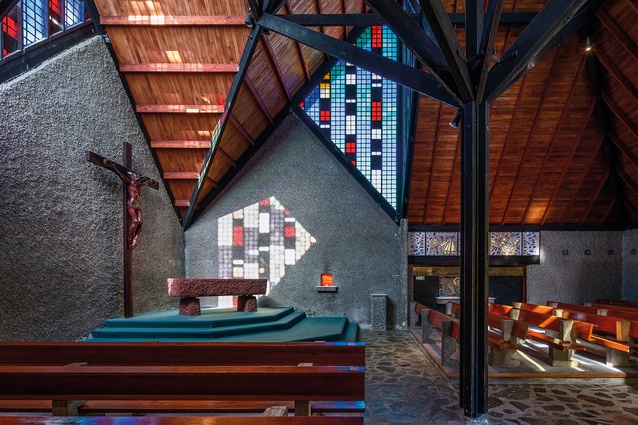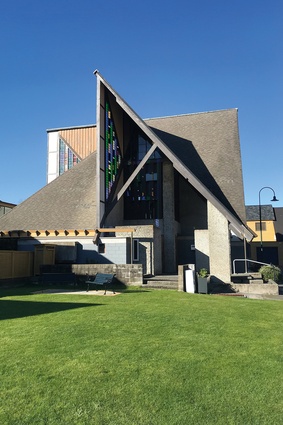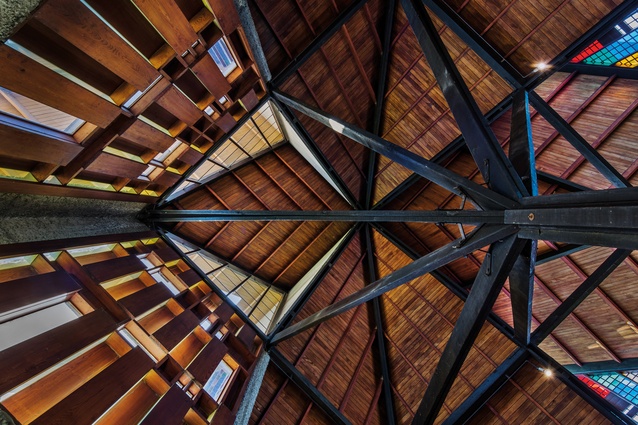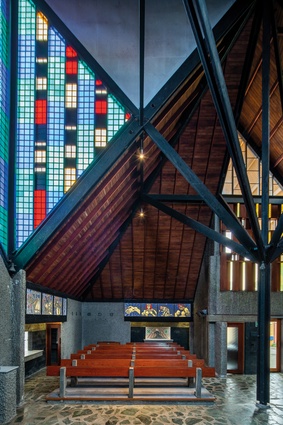A grave concern
As part of his research into the nature of sacred places, Bishop Jim White visits Futuna Chapel in Wellington’s Karori and finds an architectural shrine to ‘JC’ that is insensitive to consecrated space and to St Peter Chanel, the first Roman Catholic saint of Oceania.
On an overcast day, I slipped into the back car park, attempting to take Futuna somewhat by surprise. The building has always expected some to come by this way because there is a square red light, eternally on, to bid you and a large, looming cross cast on the outside of the concrete structure to sign you in.
Before I knew it, I was there, thrust at the pou tokomanawa, the heart pole, of the building. Pressing my hand against this tree of life, I looked up to the roof to find I was holding the giant shaft of an umbrella, which had been broken by the wind.1
There, just a short distance past this pou, in the eastern corner with the roof folding down, maybe wind-lashed or with the sheer weight of heaven pressing it down to earth, is the massive stone altar. Dried-blood red, it is raised on a stepped platform. A slightly larger-than-life-sized mahogany corpus, with a recognisable Polynesian form, overlooks from a large wooden crucifix.
From the pou tokomanawa, one can go left or right to one or other set of solidly built pews, one step up, each making a part of an ‘L’ shape. Even on a dull day, one can appreciate the presence and play of light throughout the building. The high, coloured windows promise so much. Most impressive this day was the back-lit frieze wrapping around the top rim of the walls – the Stations of the Cross – which appear to be the only procession the building really contemplated, since there is no centre aisle. The space invites mostly sitting, eliciting a stillness and contemplation.

There was no taking this building by surprise. Regarded as the key work of John Scott, New Zealand’s first Māori architect to achieve national recognition for the quality of his work, it is probably the most reflected upon and written about building in Aotearoa. Futuna received an NZIA Gold Medal in 1968 and an NZIA 25-year Award in 1986 and was the subject of a major book, Voices of Silence, by Russell Walden in 1987.
Other examples of the extensive architectural writing around the chapel and its historicity include: Deidre Brown’s Māori Architecture: From Fale to Wharenui and Beyond; and Nick Bevin and Gregory O’Brien’s, Life of a Building: Futuna. In 2015, it was part of the New Zealand Pavilion’s exhibit at the 14th International Architectural Exhibition in Venice. Bill McKay’s Worship: A History of New Zealand Church Design has it as the cover photograph.
It is a building of considerable significance, generally, let alone religiously. I carried some of this writing and reflection with me up the first flight of the temple steps.
The building is said to have elements that refer to indigenous Māori wharenui and Pacific fale, Gothic roof angles/lines, and resonances from Le Corbusier’s Chapelle Notre-Dame du Haut de Ronchamp and Matisse’s Chapelle du Rosaire de Vence. For the architect, John Scott, the New Zealand woolshed was the quintessentially successful building because it is so deeply functional, it represents a collaborative effort and it is “a symbol for all New Zealanders”.2 So, Russell Walden is glad to elegise the same intentions in Futuna. It is, of course, all of these things; as John Scott described it, it is “a conglomerate mess”. Walden announces: “Here we can view our true identity as New Zealanders.”
I wanted to set aside all of this ‘foreknowledge’ in my visit and experience the text/texture of the building afresh. It is, however, an inescapable feature of many religious/sacred spaces that they are ‘saturated spaces’ – saturated with layers of story, polyphonic and even discordant resonances from a chorus, and we often bring them with us, or, indeed, they are exactly what draws us to the space.
It was unclear to me whether or not and in what way I might engage with the many texts that make up the legend of ‘Futuna’ but, when it came to leaving Futuna, I could not let two related matters rest easy – the departure of the Society of Mary and the ongoing status of the Chapel of St Joseph (to give it its proper title), and what should have happened after the Society left.
First, some history. Life of a Building: Futuna tells us that, on 28 April 1841, Father Peter Chanel was killed on the island of Futuna. First buried in the Bay of Islands at Pompallier House, his remains were taken in 1850 to the Mother House of the Society of Mary in Lyon, France. On 17 November 1889, he was declared a martyr and beatified by Pope Leo XIII. Small fragments of his bones were distributed as relics. On 12 June 1954, Father Peter Chanel was canonised as the first Roman Catholic saint of Oceania.
On 19 March 1961, Futuna Chapel, designed by John Scott, was blessed and opened by his Grace Archbishop P.T.B. McKeefry. In April 1977, bones of St Peter Chanel were returned from France to Futuna and, in 1986, the skull of St Peter Chanel was returned to Futuna. In February 2001, the Society of Mary left the building, selling the whole Futuna Retreat Centre to property developers, Prime Properties Limited. The developers moved with some haste and started removing items from the chapel, including dismantling and removing the pews. Stepping in to stop the destruction was the Futuna Trust, which purchased the chapel from Prime Properties on 31 July 2006.

Consecrated or not
There is some confusion over whether or not the Chapel of St Joseph is ‘consecrated’. Part of the confusion is that ‘Consecration’ was not a term in any Roman Catholic official usage at that time. The actual term for the permanent setting aside of a religious building in the Roman Catholic Church is ‘Dedication’. St Joseph’s Chapel was ‘Blessed’ rather than dedicated on the Feast of St Joseph in 1961 because, as Walden writes: “Under church law, no religious building can be consecrated until it is debt-free”. Futuna was still short of completion when it was opened; the mosaics for the side chapels were not finished and the sculpted/carved corpus for the crucifix was not installed until August 1961.
What is unclear is whether or not or when the relics were placed in the altar. No such event is formally reported. However, the Marist Messenger of May 1961, reporting on the opening, states: “As might be expected, the three-and-a-half-ton altar will contain relics of St Peter Chanel”.
While one might assume that, at the time of the opening, the Society was still awaiting possession of appropriate relics,3 it is reasonable to believe, based on the following email correspondence from Brother Robert Johnsen S.M., that relics of St Peter Chanel were placed in the altars at some point:
“I was the last person out of the chapel – I turned out the lights and locked the doors on settlement day [2001] when Father John Fitzsimmons (RIP) vacated the property. I have no knowledge of the main altar relic being removed nor the relics in the four side altars being removed. I did visit the chapel later when the Futuna Trust got under way and had open visiting. I made it my business to inspect the altars for relics and I detected no change in appearance to the sealed relic inserts.”4
It was, then, the understanding of members of the Society that relics had been deposited at some point in time after the opening. The ‘reliquaries’ in the altars still appear to be properly sealed with a permanent sealant/mortar. Short of conclusive evidence coming to light, the only definitive check would entail opening the reliquaries.
In 1986, the chapel was dedicated by Cardinal Tom Williams. Again, there is some confusion because the term ‘Dedication’ applies here in two related senses: referring to the solemn dedication that permanently sets aside the building for sacred use and, also, to the fact that the chapel is ‘dedicated’ (‘named’) for St Joseph.5 Nonetheless, the Anointing of the Altar and the Consecration Stones, which is, arguably, the distinctive and central liturgical action of a Dedication, occurred that day.6 In sum, it is the case that the chapel was ‘Blessed’ in 1961, as was proper, and then ‘Dedicated’ as the Chapel of St Joseph in 1986. It seems almost certain that relics of St Peter Chanel were placed in the altars at some point between these dates. As the Roman Catholic Church understands it, the status of the chapel was that it was as sacred as it could possibly have been.

In 2001, the Society of Mary sold the whole Futuna Retreat Centre site, including the Chapel of St Joseph. The reasons expressed for doing so were a desire to recommit to the distinctive charism of the Society and a significant decline in the number of vocations to the Order.7 In short, with limited and diminishing resources, the Society couldn’t continue to maintain its ministry in Karori. It seems though that, having made the decision, the Society just ‘walked away’. In terms of the chapel, there is no record of a Liturgy of ‘Deconsecration’ or, as it is termed in the 1983 Canons, “Relegation to profane use” (Canon 1222§1).8 Obviously, some sacred items were removed (tabernacle, chalices) but, significantly, the relics of St Peter Chanel remained.9
Also remaining were the crucifix and the corpus. It is fascinating (and wonderful) that some person(s) removed – stole? – the corpus and, as it turned out, ‘saved’ it from major damage or destruction.10 It is, however, perplexing that such a significant piece of religious sculpture was left by the Marists and it is ironic that it should be someone else who would secrete the artwork away for safekeeping. But, it is more perplexing (although less obvious to the casual observer in the chapel) that the relics were left behind. Bevin and O’Brien write that the fact that “sacred items were left in the chapel at the time of sale suggests either negligence or, as the Marists themselves claim, a misplaced belief that the developers would be suitable custodians”.
Grave causes
The 1983 Canons speak of ‘grave causes’ for the closure of a church. It could not be said that the Society of Mary took their closing of St Joseph’s with anything like the gravity that they should have. The questions that arise are: What has happened to the chapel? and What should have happened to it? Because the chapel can rightly be considered iconic, the answers and issues seem particularly complex.
What has happened to the chapel is that it has been ‘saved’ by the Futuna Trust. The Trust has volunteered many hours, raised thousands of dollars and overseen considerable repair and restoration works. What has been achieved is truly remarkable and a testament to both the way in which the building is valued by the wider community and the dedication of some very generous individuals.
Today, the Trust hosts ‘Open Days’ so that people can view the chapel and it makes the building available to the wider community for concerts and the like. It has also been a venue for several architectural conferences and events. In my analysis, this is the actual purpose of the chapel today – an icon for the architectural community.
The stunning, and now emblematic, photographs by Gavin Woodward, first presented in Walden’s book and then in Bevin and O’Brien’s, are now the primary images of the chapel. For most of these photographs, the ambo, the stand from which the Gospel is read, and presider’s chair were removed. While these items were central to the functioning of the building, they were not part of the original design, and not part of the preferred and ‘staged’ image.
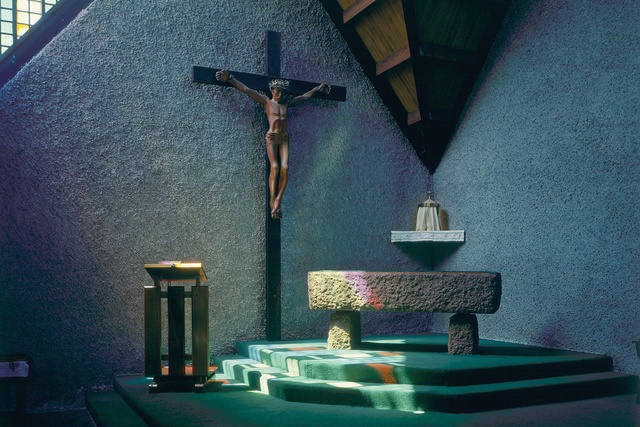
But, the most significant and, possibly, most sacrilegious change to the building today is that, on each of the side altars, where once the elements of the Eucharist (the sacramental bread and sacramental wine) were placed to be consecrated, there is now an architectural model of the chapel for ocular devotion and the receipt of blessing.
Taken together, the building now ‘reads’ as a chapel of devotion to ‘JC’, as John Scott was known in his home region of Hawke’s Bay, the architect. Perhaps, in a wider sense, it is now a chapel to ‘the architect as hero, the great designer’. I do not think that this is an outcome that Scott would have endorsed or welcomed in any way. His correspondence with Jim Allen, who is responsible for the design of the Stations of the Cross and the coloured windows and, hence, the much (and rightly) lauded features of light within the chapel, makes it clear that he considers him an equal partner in the design enterprise.
Symbolically, the dust jacket for Walden’s book places their photos alongside each other and this is in line with this thinking. I think it is also the case that Scott would share credit with the Marist ‘building brothers’, whose remarkable achievement, given they were essentially amateurs, is too easily forgotten and buried.
Raised/Razed
The other question that arises is: What should have happened to the chapel? I venture a provocative answer and it is prompted by the claim that the building represents something important in a bicultural sense. Walden says “it speaks powerfully to Māori and Pākehā consciousness” and, in the TV series, The Elegant Shed, David Mitchell announced that it was an “iconic bicultural building”.
In an interview with Walden, Scott states: “The wharepuni has a spiritual basis and the building itself is unimportant. What is important is that the building represents a person and, without this, it has no value in terms of its spiritual purpose of the Māori.”
What is usual for a wharenui that is no longer in use is that it is razed to the ground. This is confirmed in personal correspondence with Te Tai Tokerau Anglican Pihopa, Te Kitohi Pikaahu, who writes: “When a wharenui or a papa kainga (homestead) has concluded its purpose and use, it is disposed of: either by burning it and burying the ashes on the site on which it was built or the building is pulled down and the materials, especially the timber, is buried in some ordered fashion.”
There is a simple analogy here for non-Māori to see and appreciate. If the building is seen as akin to an ancestor and having its own ‘life’, then, on completion of that life, the body should be properly disposed of in a manner such as burial.11
So, while it will no doubt be seen as ‘sacrilegious’ to some, ironically, it could be that Prime Properties, the property developers who set about razing the chapel, might have been doing the right and proper thing. In this sense, the permanent removal of the kneelers can be read as a good (but insufficient) symbol of the removal of the life of prayer that was once the purpose of the chapel.

The counterpoint, however, is that, as it currently stands, there is something deeply sacrilegious to the ‘mauri’ of the space that it continues as it is. This is, after all, a space that is named for St Joseph and houses the bones of a great ancestor of the faith. It also houses works of art of religious devotion (particularly the corpus) and the altars themselves (particularly the main altar), which are so intimately associated with and symbolise on some levels, the body of Christ. It is a consecrated sacred space that is now used for other purposes.
I am aware that sensibilities in Aotearoa are such that we are likely to afford Māori spirituality and world views a kind of respect and concern that would not currently be afforded to Christian spirituality. But, my claim is that the building should have genuinely ceased and ended its previous consecrated life and then have been freed for some other use, that somehow is mindful of its previous life and, therefore, continued sacred associations.
In 2011, there was a 50th-anniversary Mass held in the chapel on St Joseph’s Day. Because the chapel is still dedicated (and the altar blessed), it is still permissible for the priest to preside at the Eucharist. I contend that it should not be permissible because the space (the altar) should be ‘relegated’ to profane use.
A building of this kind needs to be enabled to be a new thing that will be, at the same time, a ruin of its previous life. There should have been a proper ‘Liturgy of Relegation’, including the removal of sacred items and relics. The altar should have been removed, destroyed or possibly broken and fractured in a way such that it could remain but, now, as a ruin.
At one point, architectural studio Novak+Middleton was awarded runner-up in a design competition that presented the chapel uplifted and moved to the Wellington waterfront to stand beside Te Papa Tongarewa (Museum of New Zealand) as a permanent ‘artwork’. No doubt some architects would shudder at the notion that the building could be removed from the site because, in some ‘essential’ way, it would cease to be what it is but that is the point. It would have become something else in a very obvious way.
As it turns out, it has become (is becoming) an ‘icon’ for architecture and there is a great deal of effort being made to conserve the building as well as honour the profession with regular architecture conferences. Having been properly ‘relegated’, it would then, however, be up to some officiant of the Institute of Architects to set about dedicating the chapel to that purpose and giving it a new name – because it will no longer be the ‘Chapel of St Joseph’; for architects, it has always been called ‘Futuna’, which is the island on which Peter Chanel died.
Bishop Jim White is the Assistant Bishop in the Anglican Diocese of Auckland. Because, in the Anglican tradition, it is the responsibility of a bishop to consecrate or deconsecrate a church building, White has taken forward some of his thinking into a soon-to-be-completed doctoral thesis on ‘Sacred Space’. His academic background is in theology and philosophy, and he has studied at the universities of Auckland and Otago, and Yale University. Some of his best friends are architects.
1 See Gregory O’Brien’s poem ‘Ode to Futuna’: “… the centre pole – an umbrella shaft, reminding us of a storm-tossed world…” in Nick Bevin and Gregory O’Brien (eds.) Life of a Building: Futuna (Wellington: Victoria University Press, 2016), pp. 111–114.
2 Interview with John Scott, quoted in Russell Walden, Voices of Silence (Wellington: Victoria University Press, 1987), p. 149.
3 There have been two main efforts to return relics of St Peter Chanel to Futuna but relics remain ‘well distributed’ and rest in the altars of St Patrick’s Cathedral, Auckland, and the Cathedral of the Blessed Sacrament, Christchurch, and at the Marist Seminary in Auckland.
4 Personal email correspondence with Elizabeth Charlton, Archivist, Society of Mary, 11 March 2019.
5 The early Brothers were referred to as the Brothers of St Joseph.
6 The 1986 liturgical handout includes a direct introductory quotation from the ‘Rite of Dedication of a Church and an Altar’, making it clear that this was the intention of the gathering.
7 Marilyn Pryor, ‘Futuna Retreat Centre to Close’, WelCom, July 1998.
8 This would have been an ‘act of the Bishop’ (as we term it in the Anglican Church) but there is no record in the archives of the Archdiocese of any such ‘relegation’.
9 While there is no Canon stipulating such, for obvious reasons, some guidelines suggest the removal/destruction of the altar should occur at ‘relegation’.
10 The sculpture was removed in 2001 and disappeared. It was returned in 2012 after a Radio New Zealand interview prompted an anonymous listener. See Bevin and O’Brien, Life of a Building: Futuna, p. 148.
11 It is worth noting that other sacred materials are required to be obliterated – elements of the Eucharist must be consumed or, in the case of Holy Oils, they are to be burned.

